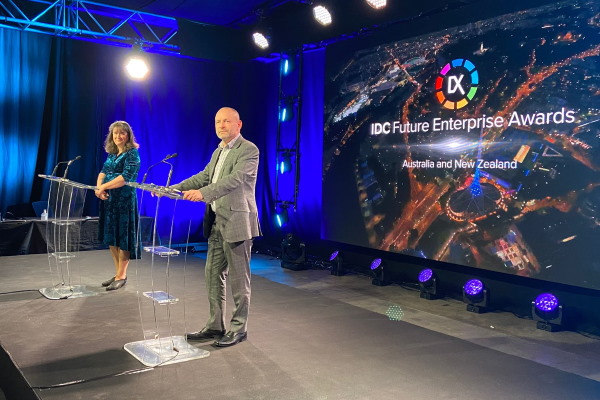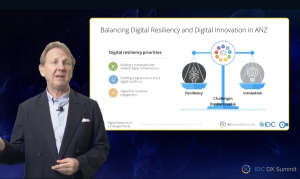Published on the 14/10/2021 | Written by Heather Wright

A blueprint for managing tension…
For A/NZ organisations balancing the need for digital resiliency versus maintaining digital innovation, there’s a pathway that will mean they can enjoy both, say IDC.
Speaking at this week’s IDC DX Summit, Chris Marshall, IDC AVP, offered up a blueprint to manage the tension between the two, often apparently conflicting, needs, which are front of mind for many Australian and New Zealand CIOs.
An IDC survey into CEOs top business concerns for the coming year saw respondents consistently noting both resiliency concerns and innovation concerns.
Both create business and financial value and with both there are significant economies of scale and scope.
“It poses the broader issue of how do enterprises manage the balance between the sometimes conflicting agendas and how do we measure and compare the business value in particularly resiliency and innovation initiatives,” Marshall says.
 “Digital resiliency and digital innovation are both important aspects of your digital investment strategy but they have very different use cases, different stakeholders and different agendas. Both are essential and both will probably continue to be essential by virtue of the seemingly evermore complex connected world we all operate in.”
“Digital resiliency and digital innovation are both important aspects of your digital investment strategy but they have very different use cases, different stakeholders and different agendas. Both are essential and both will probably continue to be essential by virtue of the seemingly evermore complex connected world we all operate in.”
Both, he says, create business and financial value and with both there are significant economies of scale and scope.
Digital resiliency requires enabling a digital culture and a digital workforce, digital first customer engagement (something New Zealand apparently is lagging at) and the building of a sustainable and resilient digital infrastructure.
That infrastructure, which IDC says needs to be an open, integrated and wholistic technology architecture, is typically built on an intelligent core of data analytics, automation and decision support, as well as a wide variety of intelligent applications, APIs and intelligent services, such as data governance, security, DevOps and data orchestration.
“Typical resiliency initiatives that A/NZ organisations have prioritised include digital infrastructure, connectivity for hybrid working and workplace transformation, as well as a number of customer experience programs and to a lesser extent data optimisation and DevOps,” Marshall says.
While the initiatives were ‘pretty consistent’ across both Australia and New Zealand, there were some differences with New Zealand companies wanting to shore up weaknesses in customer experience, while Austrian companies wanted to improve their digital infrastructure.
“Digital infrastructure was noted as a resiliency priority in A/NZ particularly in terms of the sustainability of the core digital infrastructure like data centres, edge platforms and the like.
“This plays well with a strong drive to the cloud in Australia and we are starting to see significant performance benefits for theses companies that do make these investments in sustainable infrastructure.”
On the innovation side priorities are focused around creating empathy with customers and innovative CX, collaboration across industries and ecosystems and enterprise intelligence and monetisation.
“It’s worth noting that organisations are still at very different stages in their DX journey in AN/Z and across the region,” Marshall says. “Fewer than a third have actually developed an integrated enterprise approach to innovation, and less than eight percent have been able to translate this innovation into new business model and new markets, so there is still a lot to do.”
Marshall says challenges balancing resiliency and innovation range from technical architectures being unable to scale, to silo mentalities and a lack of data literacy and general lack of skills.
“But the benefits are real. Associated with the different levels of DX maturity are different levels of financial impacts and these increase steadily until we reach the final level of maturity,” he says.
Fifty-nine percent of organisations in the second highest DX maturity category reported more than 10 percent improvements in their financial KPIs as a result of the digital investments.
“This creation of business value from digital investments in resiliency and in innovation also has an industry component. DX leaders are likely to share significantly higher revenues and to some extent higher profits too.
“More advanced industries, say banking, tends to show bigger gaps between the leaders and laggards in terms of their digital maturity, than do less advanced ones such as healthcare or telco.”
And, at least for the time being, Marshall says many industries see increasing returns for the digital investments, further widening the gap between the leaders and the laggards.
So how do companies strike the balance?
Marshall outlined a number of steps, starting with creating a formal DX strategy that incorporates digital resiliency and innovation goals, and an integrated technology road map that goes beyond the traditional silos.
“You also need to assess the skills that are needed today and that are likely to be needed in the next few years. Now with this in mind you need to consider what business processes can be further automated and transformed with the use of technologies like RPA, intelligent automation or AI.
“Then you might want to focus on data leverage and data monetisation. The shift to digital first means data becomes the primary means of understanding your customers, your employees, your competitors – everything really.”
The final step is to consider the right technologies to use, with Marshall cautioning technology is only ever a means to an end.
“Therefore you need to ensure that your investments in technology are directly linked to the business through well-defined, precisely calibrated business metrics that help you demonstrate the business value of your projects and future proof your enterprise making endemic the whole DX process to your organisation.”
DX Future Enterprise Awards winners
The Summit also saw the announcement of the A/NZ DX Future Enterprise Award winners, with New Zealand’s Earthquake Commission taking out the Future Enterprise of the Year award as well as the Future of Industry Ecosystems award. Auckland Airport also took double glory, winning both the Best in Future of Operations and the Special Award for Digital Resiliency.
Waste Management won the Future of Connectedness category, with Cue Clothing winning Best in Future of Customers and Consumers and Todd Energy claiming Best in Digital Infrastructure.
The City of Sydney took out the Digital Innovation category, with AGL winning Best in Future of Intelligence, BPay Group taking out Best in Future of Trust and Sydney Local Health District taking the Future of Work award.



























